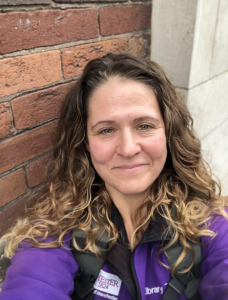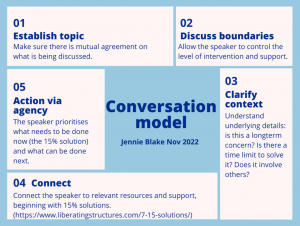Agency and advising: a model for conversation

Jennie Blake is the Academic Lead for Student Success at the University of Manchester’s Institute for Teaching and Learning, Her remit includes academic advising, student support, induction, transition and a variety of university-wide initiatives and policy. She also holds a substantive role as the Head of Teaching and Learning Development at the University of Manchester Library. There she looks after all Library teaching, both credit bearing and extracurricular, including the award-winning My Learning Essentials. She researches on areas including inclusive practice, student co-creation of learning and models for student support. She holds her Principal Fellowship of the HEA and was awarded a National Teaching Fellowship in 2018, both awards recognising her sector-leading practice and expertise in student support.
LinkedIn: https://www.linkedin.com/in/jennieblake
ORCID: https://orcid.org/0000-0003-1553-4737
This project came out of an international benchmarking initiative on advising. Those conversations made it clear that advisors often fall back on our more practiced, social, conversation skills when meeting with advisees (as I have discussed before in (link to previous blog). For those advisees whose backgrounds were different from their advisors (and especially for those whose lived experience meant they had multiple points differing from the “expected”), just “having a chat” could be potentially problematic, leaving them feeling left out of the process and unable to connect. In response to this, I worked with some students and staff to tease out a potential model for conversation with advisees. Since then, this has been taught on all three NAPs, so it may look vaguely familiar!
The model needed to do a few specific things (or at least support the doing of them). Including:
- Ensure the advisee was viewed as the expert in their own lived experience and had their voice prioritised.
- Work to establish a mutually agreed upon topic and a set of boundaries (for both advisor and advisees).
- Develop actions that would allow the advisee to take away the support, advice and resources and continue to help themselves beyond the initial conversation.
There is no expectation that this should be prescriptive or that each step must be followed each time. Although it can be used that way, it is also designed to flex within the relationship of the advisor and advisee, in whatever way works best for them.

Steps in conversation model
Each of the steps of this process are meant to support centring the voice and agency of the advisee and clarifying distinct actions for after the conversation.
- Establish topic: the advisee and advisor need to work together to establish the topic to be discussed. This is a time for the listener to empathetically collaborate with the speaker in establishing the topic to focus on, ensuring that it is clear what will be worked on.The key here would be to establish something which, if written down, would be able to encompass the theme of the conversation (or at least one of them). 2.
- Discuss boundaries: Depending on the topic and its context, different levels of intervention might be welcome and appropriate. Do they prefer advice and then to be left alone? Do they want formal support? Something long term? Having this discussion on purpose and then reflecting on (and recording) decisions around boundaries can help make clear the expectations both students and staff can have around the intervention, support and wider relationship. 3.
- Clarify context: Now that the topic, and limitations, have been established, this is a good moment to ask if there are any other people involved, if the issue is long-term or if there is a need for a quick solution because of outside pressures or time limits.
- Connect: this is the time to do what feels “typical” for many advisor/advisee conversations, connecting students to support services, resources or other people that could help. Within this model, the connections are:
- Framed by the earlier conversation
- Focused predominantly on connections, steps and actions that can be taken “now”. It might be helpful to frame this with the 15% solution model (a liberatory practice exercise, link here: Liberating Structures webpage).
- Lightly touches on what might be done “next”: in case it is appropriate to have a few next steps discussed alongside the “now”
Action via agency: Now we would expect the advisee to walk away with individual actions. This doesn’t mean that help in the form of support to book an appointment or come up with a plan is inappropriate, but that the focus needs to stay on the speaker. This is where the 15% solution helps, as discussing what is possible, with no additional resource or support, will clarify what is possible to address.
This model has been generally available for around a year, and we are just getting ready to start wandering round asking if anyone has been able to use it and how it went. If you’re curious about it, or have tried it out yourself, please do get in touch!







0 Comments